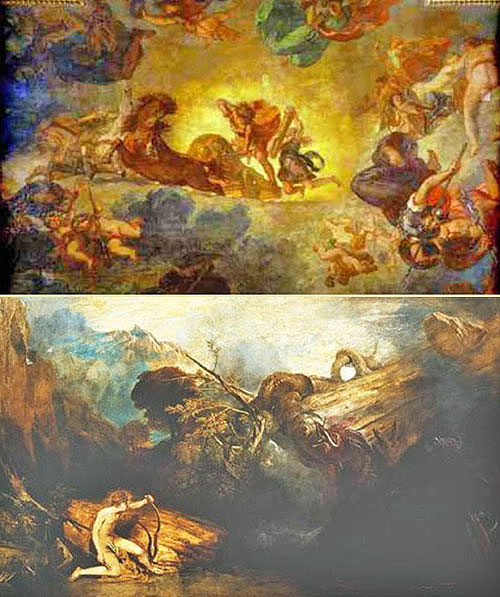|

Oct 07, 2004

It is fascinating to follow the historic evolution of the
cosmic
thunderbolt, as the divine weapon of the gods passed into the
sword,
spear, arrow, or club of the most famous heroes of later times. Of
course mythologists will not normally think of the arrow of Apollo,
the sword of Perseus, or the club of Heracles as electric in nature.
One reason for this is that, as the early gods of the thunderbolt
evolved over the centuries, the chroniclers gradually reduced them
to human dimensions. A celestial warrior bearing the thunderbolt in
battle later lost his cosmic attributes to become a great man, the
best of heroes, the esteemed ancestor of the tribe or nation telling
the story.
In such cases the original identity of the magical weapon had
already slipped into the background, though only rarely could it be
hidden entirely. Often, what we get is just a shadow of the cosmic
missile so vividly described in early Near Eastern narratives of
primeval order and chaos.
As a bridge between the more archaic world and the fragmented and
diluted myths of later times, Greek accounts offer many clues
pointing to the evolution of the symbolism. The Homeric Hymn to Pythian Apollo describes the hero’s confrontation with the chaos
serpent Python, whom the chroniclers identified alternately as a
form of the dragon Typhon or as the nurse of Typhon. The
Homeric and
other accounts refer to the invincible "arrow" launched by
Apollo,
causing the monster to shudder violently and to give up its life in
a torrent of blood.
The ambiguity as to the setting of the mythic accounts is emphasized
in the two paintings above, depicting Apollo’s defeat of
Python. The
upper painting by Eugène Delacroix has preserved many touches of the
original celestial context, while the lower by J. M. W, Turner is
much more terrestrial in its setting.
Did the "arrow" of Apollo really mean the
cosmic thunderbolt, the
weapon that so often, in the earlier Near Eastern accounts, took the
form of an arrow? The most respected experts on Greek mythology and
symbolism assure us that arrows or swords wielded by the revered
gods of Greece cannot be separated from the language of the
thunderbolt. The connection is apparent in the Greek
keraunós,
"thunderbolt," most commonly used for Zeus’
weapon and said to stem
from a Proto-Indo-European root "ker." The same root appears to lie
behind the Sanskrit "áru", ’arrow’ and the
Gothic haírus, ’sword.’
This should not surprise us, since the most familiar representations
of the "eagle" of Zeus (as, of course, the eagle of the
Latin
Jupiter) depict the god’s lightning as arrows held in the talons of
the bird - a representation well preserved into modern times by the
symbol of the eagle and its lightning-arrows on the U.S. one dollar
bill.
The same association holds true for the sword of Apollo. The god’s
epithet was chrysáoros or chrysáor - meaning "of the Golden Sword" (áor).
According to the distinguished authority, W. H. Roscher, the
Golden
Sword is a Greek hieroglyph for the thunderbolt. Indeed
Zeus
himself, the most famous wielder of the thunderbolt, was
Chrysaoreús
or Chrysaórios, "He of the Golden Sword".
In much the same way, the poet Pindar speaks of Zeus "whose spear is
lightning", while Aristophanes invokes lighting as "the immortal
fiery spear of Zeus". In the words of the poet Nonnus,
Zeus is,
"the
javelin-thrower of the thunderbolt".
"The spear he shook [in the
battle with Typhon] was lightning."
"Do thou in battle lift thy
lightning-flash, Olympus’ luminous spear".
The question is worth pursuing, therefore: have
historians and
mythologists missed the true identity of the far-famed hero and his
weapon?
|
